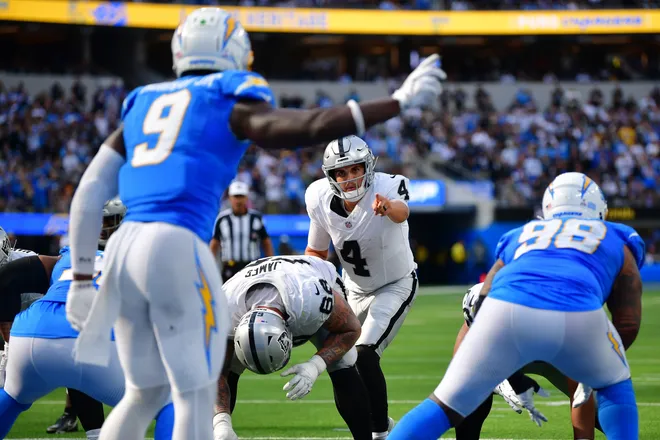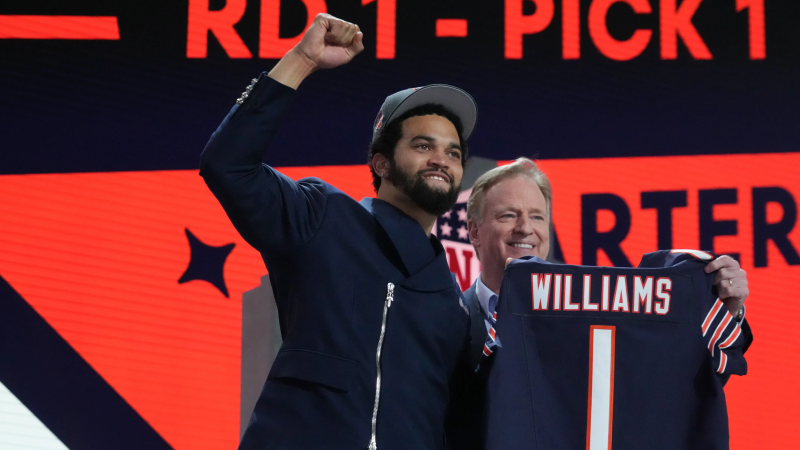With the 2024 NFL draft in the rearview mirror, these 6 teams have big needs to address
The 2024 NFL draft is in the books, and while we know the winners and losers, there are still plenty of questions left to answer.
Mainly, many teams filled major holes on their rosters, but some still have gaps they need to address prior to the start of the 2024 season.
The biggest problem? For those teams that still do have holes, aside from trades executed in the months leading up to training camp and the start of the season, the only other opportunity to add depth and talent will be around cut day, when teams whittle their rosters down to 53 players in late August.
Here’s a look at the NFL teams that still have significant needs even after the 2024 NFL draft.
Las Vegas Raiders: quarterback

Arguably the most glaring deficiency left unfulfilled, the Raiders are retaining uncertainty at the sport’s most important position. To a certain extent, Las Vegas was a victim of circumstance; the Raiders held the No. 13 overall selection in the first round, and with the Atlanta Falcons picking Michael Penix Jr. (No. 8), the Minnesota Vikings trading up to take J.J. McCarthy (No. 10) and then the Denver Broncos perhaps reaching for Bo Nix at No. 12, the Raiders made do and drafted the best player available. Tight end Brock Bowers is an offensive weapon who should stretch the field and contribute right away.
NFL DRAFT HUB: Latest NFL Draft mock drafts, news, live picks, grades and analysis.
The Raiders, of course, could’ve invested draft capital to move up to take a quarterback. But the Raiders felt confident enough last season in Aidan O’Connell to bench Jimmy Garoppolo. Still, O’Connell and free agent acquisition Gardner Minshew are far from game-changers at the position and the team will almost certainly address its need at quarterback in the near future.
Dallas Cowboys: running back
Sometimes the draft simply plays out where a team may be targeting a player at a position of need, only to see him drafted several slots ahead of their position. That may have been the case (twice) for the Cowboys, who lost running back Tony Pollard in free agency to the Tennessee Titans.
Ten slots before Dallas was set to pick late in the second round (No. 54 overall), the Carolina Panthers selected in-state running back Jonathan Brooks, who played for the Texas Longhorns. Then, in the third round, the Cowboys may have been looking to answer their running back need with Florida State’s Trey Benson, whom the Arizona Cardinals selected seven picks before Dallas drafted Kansas State guard Cooper Beebe at No. 73. Team owner Jerry Jones and the Cowboys haven’t shied away from using premium draft capital for running backs, an integral position in coach Mike McCarthy’s offense. The team is apparently reuniting with Ezekiel Elliott, but he’s an aging back in decline who posted career lows in starts (five), attempts (184), rushing yards (642), rushing touchdowns (three), first downs (33), yards per carry (3.5) and longest rush (17 yards) in 2023.
Miami Dolphins: defensive tackle
On one hand, it made sense that the Dolphins didn’t re-sign Christian Wilkins in free agency; Wilkins drew what would’ve been a massive pay increase before he eventually signed with the Raiders. Yet, the Dolphins failed to adequately replace Wilkins, whose nine sacks in 2023 and disruptive presence on the interior of the defensive line were essential to Miami’s operation.
The Dolphins did draft Penn State edge rusher Chop Robinson (No. 21 overall) to bolster their overall defensive line health, but with Bradley Chubb (torn anterior cruciate ligament) and Jaelen Phillips (torn Achilles) recovering from significant injuries, the unit could struggle without an anchor in the middle. Unproven third-year pro Benito Jones is likely to step in for Wilkins, a clear downgrade at the position.
Atlanta Falcons: edge rusher
The Falcons ranked in the NFL last season in sacks per pass attempt (7.65%), and that was with their leading – but aging – edge rushers Bud Dupree and Calais Campbell on the team. Dupree and Campbell tied for the team lead in sacks with 6.5, and each saw their contracts expire at the end of the 2023 season. This is what makes Atlanta's selection of Michael Penix Jr. at No. 8 overall – after the Falcons had signed Kirk Cousins to a deal with $100 million in guaranteed money – all the more confounding.
The Falcons realistically could’ve traded back to stash some more draft capital, fill actual needs and reaffirm the team’s win-now moves. This is only magnified given that a record number of offensive players, 14, were taken to start the draft. The Falcons could’ve easily fallen back to take UCLA edge rusher Laiatu Latu, who went No. 15 to the Indianapolis Colts, or Alabama’s Dallas Turner, who went No. 17 to the Minnesota Vikings.
Baltimore Ravens: offensive line
The Ravens deserve credit for building consistently solid offensive lines over the past several seasons, so some benefit of the doubt should be applied to their process. Still, Baltimore’s offensive front had three of its five starters leave this offseason, with guards John Simpson and Kevin Zeitler signing elsewhere in free agency and right tackle Morgan Moses traded to the New York Jets.
The Ravens used two of their nine picks on offensive linemen, with Washington right tackle Roger Rosengarten (No. 62 overall) likely being thrust into a starting role as a rookie. The Ravens might opt to move Rosengarten inside to one of the guard spots and rely on the larger Daniel Faalele, a 2022 fourth-rounder, to man the right tackle spot. Baltimore’s other offensive line draft selection was a seventh-round flyer on Michigan State center Nick Samac, who may not contribute for seasons, if he does at all. That still leaves massive questions at right tackle and at least one of the guard positions. Considering that left tackle Ronnie Stanley is entering the final season of his contract and has played in just 31 games since 2020, the team’s lack of depth along the entire offensive line is even more concerning.
Buffalo Bills: wide receiver

Yes, the Bills used their first selection after they traded out of the first round to pick a wide receiver in Florida State’s Keon Coleman (No. 33 overall). But, no, that is not enough to fully address the need at the position. Coleman should be a Day 1 starter, but he’ll be (unfairly) tasked to replace Stefon Diggs, a player who was nominated to Pro Bowls in each of his four seasons in Buffalo and accounted for 5,372 receiving yards and 37 touchdowns during that span.
Frankly, Coleman may be better suited in the NFL to become an eventual No. 2 option, though he should find some success in the red zone. Still, the Bills actually lost more than Diggs, as previous No. 2 receiver Gabe Davis signed with the Jacksonville Jaguars this offseason.
Disclaimer: The copyright of this article belongs to the original author. Reposting this article is solely for the purpose of information dissemination and does not constitute any investment advice. If there is any infringement, please contact us immediately. We will make corrections or deletions as necessary. Thank you.







